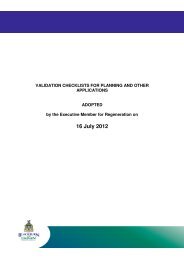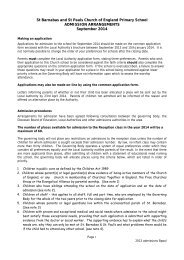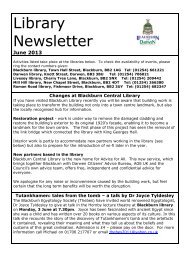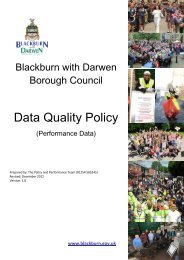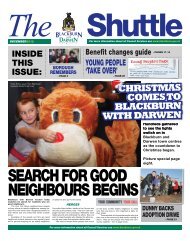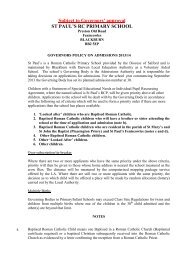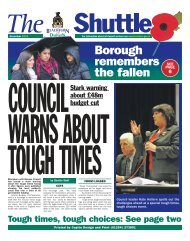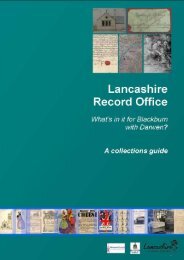Statement of Accounts 2011/2012 - Blackburn with Darwen Borough ...
Statement of Accounts 2011/2012 - Blackburn with Darwen Borough ...
Statement of Accounts 2011/2012 - Blackburn with Darwen Borough ...
Create successful ePaper yourself
Turn your PDF publications into a flip-book with our unique Google optimized e-Paper software.
NOTES TO THE FINANCIAL STATEMENTS<br />
Contingent assets<br />
A contingent asset arises where an event has taken place that gives the Council a possible asset whose<br />
existence will only be confirmed by the occurrence or otherwise <strong>of</strong> uncertain future events not wholly <strong>with</strong>in the<br />
control <strong>of</strong> the Council.<br />
Contingent assets are not recognised in the Balance Sheet but disclosed in a note to the accounts where it is<br />
probable that there will be an inflow <strong>of</strong> economic benefits or service potential.<br />
u) Reserves<br />
The Council sets aside specific amounts as reserves for future policy purposes (earmarked reserves) or to cover<br />
contingencies (unallocated balances). Reserves are created by appropriating amounts out <strong>of</strong> the General Fund<br />
Balance in the Movement in Reserves <strong>Statement</strong>. When expenditure to be financed from a reserve is incurred, it<br />
is charged to the appropriate service in that year to score against the Surplus or Deficit on the Provision <strong>of</strong><br />
Services in the Comprehensive Income and Expenditure <strong>Statement</strong>. The reserve is then appropriated back into<br />
the General Fund Balance in the Movement in Reserves <strong>Statement</strong> so that there is no net charge against council<br />
tax for the expenditure.<br />
Certain reserves are kept to manage the accounting processes for non-current assets (Revaluation Reserve and<br />
Capital Adjustment Account), financial instruments, retirement and employment benefits and do not represent<br />
usable resources for the Council - further explanations are provided in the relevant policies.<br />
v) Revenue Expenditure Funded from Capital under Statute<br />
Expenditure incurred during the year that may be capitalised under statutory provisions but that does not result in<br />
the creation <strong>of</strong> a non-current asset has been charged as expenditure to the relevant service in the<br />
Comprehensive Income and Expenditure <strong>Statement</strong> in the year. These items are generally grants and<br />
expenditure on property not owned by the Council. Where the Council has determined to meet the cost <strong>of</strong> this<br />
expenditure from existing capital resources or by borrowing, a transfer in the Movement in Reserves <strong>Statement</strong><br />
from the General Fund Balance to the Capital Adjustment Account then reverses out the amounts charged so that<br />
there is no impact on the level <strong>of</strong> council tax.<br />
w) Value Added Tax<br />
VAT payable is included as an expense only to the extent that it is not recoverable from Her Majesty’s Revenue<br />
and Customs (HMRC). VAT receivable is excluded from income.<br />
x) Changes to accounting policies<br />
Where a change in accounting policy is made, it is applied retrospectively (unless stated otherwise) by adjusting<br />
opening balances and comparative amounts for the prior period as if the new policy had always applied. As a<br />
result some <strong>of</strong> the amounts presented in the financial statements are different from the equivalent figures<br />
presented in the <strong>Statement</strong> <strong>of</strong> <strong>Accounts</strong> for 2010/11.<br />
The following table explains the material differences between the amounts presented in the 2010/11 financial<br />
statements and the equivalent amounts presented in the <strong>2011</strong>/12 financial statements.<br />
New class <strong>of</strong> Non-Current Assets – Heritage Assets<br />
The <strong>2011</strong>/12 Code introduced a change to the treatment in accounting for heritage assets held by the Council, in<br />
accordance <strong>with</strong> Financial Reporting Standard (FRS) 30. For <strong>2011</strong>/12 the Council is required to change its<br />
accounting policy for heritage assets and recognised them at valuation. Previously, heritage assets were not<br />
recognised in the Balance Sheet as it was not possible to obtain cost information on the assets. The Council’s<br />
approach to the recognition and measurement <strong>of</strong> heritage assets is set out in accounting policy k).<br />
In applying the new accounting policy, the Council has recognised an additional £19,335,000 in respect <strong>of</strong><br />
heritage assets that were not previously recognised in the Balance Sheet.<br />
This has resulted in the following changes being made to the figures presented in the 2010/11 financial<br />
statements:<br />
Opening 1 April 2010 Balance Sheet<br />
2010/11<br />
<strong>Statement</strong>s<br />
Adjustments<br />
made<br />
£000 £000<br />
Heritage Assets 0 19,335<br />
Revaluation Reserve 0 ( 19,335 )<br />
- - 30 - -




